For the month of January, the Sea Grant 50th is focusing on K to Gray education—yes, that includes everyone—and within IISG there is no shortage of resources for all ages.
Terri Hallesy who has been with the IISG education team for 13 years has seen teaching trends change over the years, but in the end, she knows it’s really very simple.
“I just enjoy working with all the dynamic, engaging specialists,” Hallesy says. “They each focus on diverse programs and target different audiences. What’s great is they’re always ready to collaborate using the latest and most relevant educational tools.”
Below we are highlighting five of the projects the education team has produced—in collaboration with specialists, other Sea Grants, as well as educators—that capture that cooperative spirit.
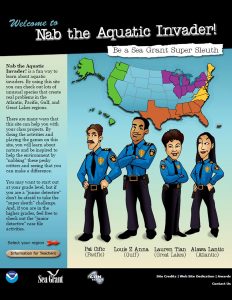 Nab the Aquatic Invader!
Nab the Aquatic Invader!
Launched in 2009, this website focuses on the suspects–aka the invasive species–in four regions of the country: Atlantic, Pacific, Gulf, and Great Lakes. In each region, visitors can see read interrogation interviews with the 10 Most Wanted AIS and learn their origin, problems they cause, and some control methods used to slow the spread of these species. The project was featured in the Smithsonian in 2010.
Collaborators included New York, Michigan, Wisconsin, Pennsylvania, and Ohio Sea Grants.
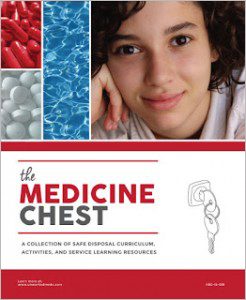 The Medicine Chest
The Medicine Chest
Illinois-Indiana Sea Grant’s (IISG), The Medicine Chest, invites high school students to metaphorically open up those doors and investigate what makes those chemicals harmful to people, pets, and the environment when improperly disposed. The curriculum was updated last year.
Collaborators included Pennsylvania Sea Grant, U.S. EPA Great Lakes National Program Office, and Paul Ritter and Eric Bohm, P2D2 Program Administrators.
Sensible Disposal of Unwanted Medicines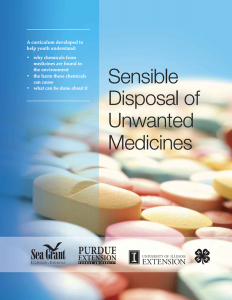
When medications are flushed down the toilet, wastewater treatment plants can’t always filter out the harmful chemicals that can affect wildlife and even get into drinking water supplies. This 4-H guidebook and curriculum, designed for informal education audiences, provides five inquiry-based lessons to help high school youth understand the harmful effects of improper disposal of medicines and what they can do to help.
Collaborators included 4-H and Penn High School, Mishawaka, Indiana.
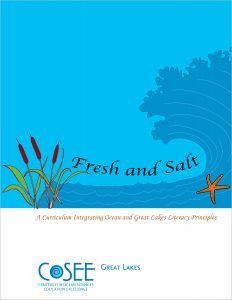 Fresh and Salt
Fresh and Salt
Fresh and Salt is a collection of activities that enhance teacher capabilities to connect Great Lakes and ocean science topics. Designed to be used by teachers in grades 5-10, this curriculum provides an interdisciplinary approach to ensure that students achieve optimum science understanding of both Great Lakes and Ocean Literacy Principles.
Collaborators included Centers for Ocean Science Education Excellence and Ashland University.
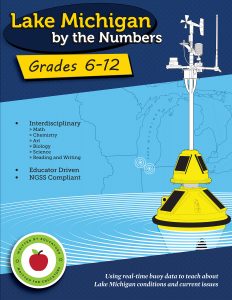 Lake Michigan by the Numbers
Lake Michigan by the Numbers
This curriculum was created by teachers who attended a day-long workshop to learn how to incorporate buoy data into their classroom instruction. They created these data-rich, STEM-based lesson plans that boost understanding of Great Lakes issues by incorporating real-time data from Great Lakes buoys.
Collaborators included Indiana Department of Natural Resources, Lake Michigan Coastal Program, and Center for Great Lakes Literacy.
Illinois-Indiana Sea Grant is a part of University of Illinois Extension and Purdue Extension.
Terri Hallesy is IISG’s new education coordinator. She has been a part of the program’s education team since 2004 and has played a key role in developing curriculum, conducting educator workshops, and designing IISG-led courses. Her list of accomplishments includes the Nab the Aquatic Invader! website and the B-WET teacher workshop. Terri has received several awards during her tenure with IISG, including an Extension Award of Excellence in 2008 for her efforts on a University of Illinois service-learning course. As the education coordinator, Terri will develop new programs and resources to build our program and improve Great Lakes education in the region. She will also oversee several state and regional collaborative education efforts, including the Center for Great Lakes Literacy project.
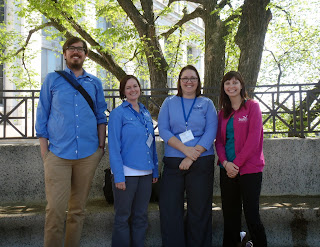 Staff members from 20 different Sea Grant programs across the U.S. attended two Sea Grant Academy sessions this year (one week in April, and one in October). The academy was developed to give Sea Grant employees valuable training and professional development information in a variety of fields, benefiting their work and the work of all Sea Grant programs at large.
Staff members from 20 different Sea Grant programs across the U.S. attended two Sea Grant Academy sessions this year (one week in April, and one in October). The academy was developed to give Sea Grant employees valuable training and professional development information in a variety of fields, benefiting their work and the work of all Sea Grant programs at large.
Five staff members from Illinois-Indiana Sea Grant were able to attend, and participated in sessions ranging from the history of Sea Grant to project design and evaluation, social science training, time management, communicating the importance of ocean science to various audiences, and much more.
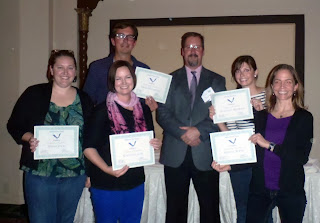 IISG’s Danielle Hilbrich, Greg Hitzroth, Kristin TePas, Kara Salazar, and Sarah Zack were among the more than 40 Sea Grant professionals who completed both weeks of training and graduated from Sea Grant Academy with new information and skills to bring to their work protecting the Great Lakes.
IISG’s Danielle Hilbrich, Greg Hitzroth, Kristin TePas, Kara Salazar, and Sarah Zack were among the more than 40 Sea Grant professionals who completed both weeks of training and graduated from Sea Grant Academy with new information and skills to bring to their work protecting the Great Lakes.
“Sea Grant Academy was a really unique opportunity to meet people from around the country that are working on the same issues we are,” said Sarah. “I thought that it was a great way to foster both partnerships between programs and friendships between specialists. I really enjoyed meeting all the attendees and hearing all about the great work they’re doing.”
 And Kristin TePas wrote, “It was a great opportunity to connect with other Sea Grant specialists from around the country. Also, hosting the meeting in Duluth provided a great opportunity to showcase our freshwater coast and the issues surrounding the Great Lakes.”
And Kristin TePas wrote, “It was a great opportunity to connect with other Sea Grant specialists from around the country. Also, hosting the meeting in Duluth provided a great opportunity to showcase our freshwater coast and the issues surrounding the Great Lakes.”
To learn more about the National Sea Grant program and the work being done to protect America’s coastal resources, visit the NOAA Sea Grant webpage.
This past summer’s B-WET workshop offered a lot of lesson and activity ideas for all of the teachers who attended, including Marea Spentzos-Inghram, middle school teacher at Catherine Cook School in Chicago.
Beyond just taking a few curriculum ideas back to her lesson prep, though, Ms. Spentzos-Inghram decided to turn her class into student scientists by becoming official precipitation observers for CoCoRaHS – the “Community Collaborative Rain, Hail, and Snow Network” – which is a volunteer network of weather watchers throughout the country. The project was even featured in the school newsletter (photo below).
“The B-WET workshop presented teachers with so much information it would be impossible to not get inspired!” said Ms. Spentzos-Inghram. “They had a lineup of AMAZING presenters from a variety of organizations to promote their efforts, which made it a one-stop shop for information about bringing Great Lakes science into the classroom.”
“Being an urban school, I felt limited in outdoor environmental opportunities but CoCoRaHs was do-able. Since I have rooftop access to my building it was easy to participate! And the students get REALLY excited when it rains because they want to see how much rain fell at our school. I can’t imagine what it will be like for snow (or other precipitation).”
Ms. Spentzos-Inghram has expanded on this experience and introduced an outreach component, with a group of students working on a PSA right now featuring a cartoon rain gauge being interviewed.
As for the benefits of the workshop, “what they had to share seemed easy (teachers like easy) yet practical, useful, and educational. And the students have really taken to it and gotten involved, which is the best part of coming back with new ideas for the classroom.”
Similar workshops are held regularly, and you can contact IISG’s Robin Goettel and Terri Hallesy for more details. You can find additional information about Great Lakes science resources and training at our education page and at the Center for Great Lakes Literacy.
IISG and the AVMA co-developed a set of five simple medication management steps for veterinarians to share with their clients: 1) use as directed, 2) store out of reach of kids and pets, 3) don’t share, 4) don’t flush down the drain or toilet, and 5) take expired or unwanted meds to a take-back program. Many of the 310 vets and vet techs that IISG spoke with at the convention were familiar with these messages, and several of them mentioned that they have the brochures available in their waiting rooms.
For the vets less familiar with the topic, Laura Kammin and Susan Boehme held a two-hour continuing education workshop to bring them up to speed. And Corrie Layfield staffed the IISG booth over the course of the 3-day event to share resources and speak directly with attendees about what medicine disposal information, if any, they already share with clients.
 IISG staffers talked with veterinarians from 30 states as well as Peru, Korea, Japan, Canada, and Italy about how they can provide proper medicine storage, use, and disposal information to their clients. Laura also networked with staff from several Colleges of Veterinary Medicine to offer information and materials for future veterinarians.
IISG staffers talked with veterinarians from 30 states as well as Peru, Korea, Japan, Canada, and Italy about how they can provide proper medicine storage, use, and disposal information to their clients. Laura also networked with staff from several Colleges of Veterinary Medicine to offer information and materials for future veterinarians. For additional information about the importance of safe and proper medicine disposal, visit www.UnwantedMeds.org, and follow Unwanted Meds on Twitter.
 Nab the Aquatic Invader!
Nab the Aquatic Invader!
 Fresh and Salt
Fresh and Salt Lake Michigan by the Numbers
Lake Michigan by the Numbers



